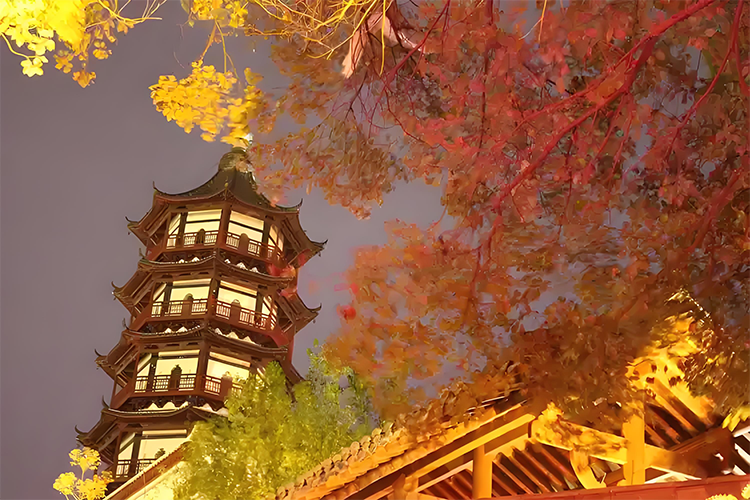Shengjin Tower Night Light Show: Ancient Pagoda Walk & Local Flavors
Introduction:
When a breeze stirs the bronze wind chimes and their clear notes drift over Nanchang’s old city, Shengjin Tower seems to shake off a thousand years. Built in the Tang era, this Jiangnan pagoda is both a spiritual symbol of well-being for locals and a living city museum—by day the old stone streets smell of slow-simmered clay-pot stew; by night the tower’s façade becomes a stage for vivid light narratives. History here is alive in every steaming bowl of banfen, every dialect hawker’s call, and the shadow-play of paper-cutting artists at the corner.
1. The Soul of a Millennium Tower
The story of Shengjin Tower begins in the Tianyou years of the Tang dynasty (904–907). The 50.86-meter-high structure stands in a seven-story, eight-sided design. Its name comes from the unique way the copper finial was fixed—wrapped with iron chains once called the “golden rope,” which gleams in sunlight. As a rare Jiangnan-style pavilion timber-and-brick tower, its craftsmanship appears in small details: 56 bronze wind chimes hang beneath the eaves, their sound once believed to ward off evil and invite good fortune. Inside, relics such as Buddhist sharira and historic inscriptions quietly tell the spiritual and literary legacy of Jiangxi.
2. An Immersive Time-Travel Experience
Shengjin offers two distinct moods between day and night:
– Daytime cultural strolls: Wander reconstructed lanes where gray bricks and black tiles hide living intangible cultural heritage. Hear the plaintive lines of Nanchang’s tea-picking opera at the Confucian temple, or sit with a paper-cutting artisan and learn to cut the “Ten Scenes of Yuzhang” from red paper.
– Nighttime light spectacle: Since 2021, the Golden Tower Night Show uses 3D projection mapping to turn the pagoda into a giant screen. Scenes from the Preface to Tengwang Pavilion, the August 1 Uprising, and other Nanchang stories stream across the tower, accompanied by water mist and holographic effects for an almost dreamlike experience.
3. Jiangxi’s Culinary Corridor for Food Lovers
The Shengjin Tower food street is a must for gourmets—here you can sample the most authentic Gan (Jiangxi) flavors in one walk:
– Three must-try items: silky, springy Nanchang banfen (mixed rice noodles), paired with a clay-pot stew simmered for eight hours, and finished with a sweet white-sugar cake. The long-established “Shengjin Tower Clay-Pot Soup” stall often has diners savoring earthenware bowls with relish.
– Hidden local treats: In a narrow alley the “Golden Tower Shaobing” is charcoal-baked to a crisp crust with savory preserved vegetable (meigan cai) filling. Locals whisper that adding chili is the truly authentic way to eat it.

4. The Local Festival Calendar: Events Not to Miss
– Spring Festival temple fair: Dragon lantern dances, pounding glutinous rice cakes, and red-couplet stalls line the streets, while the air fills with the toasty scent of fried sugar rice.
– Mid-Autumn moon banquet: After a moon-worship ceremony before the ancient pagoda, Hanfu processions carrying fish-shaped lanterns weave through the crowd, like a classical painting come to life.
5. Insider Tips from Locals
– Best photo spot: Look east of the Confucian temple on Yaota Alley for a framing of red lanterns and the tower; on rainy days the wet bluestone reflections add poetic depth.
– Beat the crowds: Arrive before 10:00 a.m. on weekends to avoid tour groups. For the light show and blue hour shots, 17:30–19:00 is the sweet spot.

Practical Information at a Glance
– Address: Shengjin Tower Street, Xihu District, Nanchang (5-minute walk from Shengjin Tower Station, Metro Lines 3 and 4)
– Hours: Street area open daily; light show nightly 19:30–21:30 (winter times start 30 minutes earlier)
– Costs: Free to enter the street area. Clay-pot stew about ¥15 per person; intangible heritage workshops ¥30–80 per session
– Tips: Some snack stalls accept cash only—carry small change. Free Wi‑Fi covers the street; look for the network “SJT-Free.”
Conclusion:
The charm of Shengjin Tower lies in its ability to let you touch Tang-era stonework and turn a corner into a meeting with a local holding a chili bowl. The tower is no longer a cold relic but a living stage linking past and present—whether you come for history, food, or the thousand-year wind chimes, Shengjin Tower offers moments that make you feel life is worth savoring.


